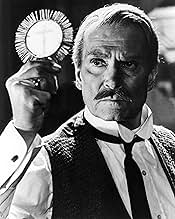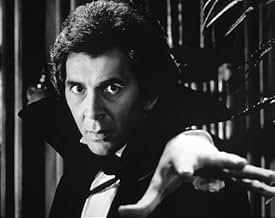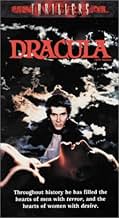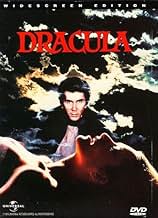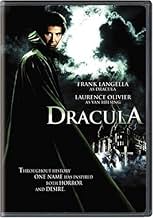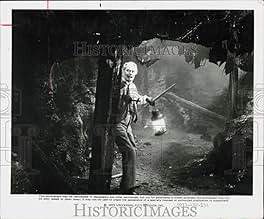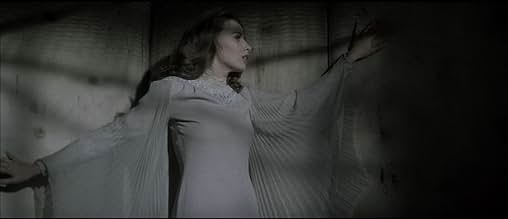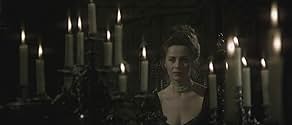IMDb-BEWERTUNG
6,5/10
11.825
IHRE BEWERTUNG
1913 reist der charmante, verführerische und finstere Vampir Graf Dracula auf der Suche nach einer unsterblichen Braut nach England.1913 reist der charmante, verführerische und finstere Vampir Graf Dracula auf der Suche nach einer unsterblichen Braut nach England.1913 reist der charmante, verführerische und finstere Vampir Graf Dracula auf der Suche nach einer unsterblichen Braut nach England.
- Auszeichnungen
- 3 Gewinne & 4 Nominierungen insgesamt
Sylvester McCoy
- Walter
- (as Sylveste McCoy)
Dan Meaden
- Asylum Nurse
- (Nicht genannt)
Empfohlene Bewertungen
It's Halloween as I write, and all the little ghouls are making their annual rounds. What better time to re-view and review my collection of vampire flicks? This version is one of the best so far in my opinion. You don't need to be Freud to understand the attraction of the vampire, and in particular Dracula. The powerful combination of sex and death (or un-death if you will) is irresistable to the human psyche. And let's admit it, who wouldn't like to live forever?
Frank Langella's take on the Count is expertly performed. His tall, dark, good looks are ideal here. Langella's astigmatism, which causes his eyes to quiver when staring, provide an eerie effect which the special effects of 1979 couldn't have achieved. As another reviewer noted, Mr. Langella had performed this role on stage before making this film, so his Dracula is smooth and well polished. His subtle spider-like hand movements are perfect here.
The beauteous Kate Nelligan provides an able foil as the strong and intelligent Lucy and Dracula's love/death interest. Note that the Lucy and Mina roles are reversed in this version, but no apparent harm is done to the story.
Olivier and Pleasence are solid but not exceptional in their roles as Drs. Van Helsing and Seward. The sets are very good, and some are wonderful (the graveyard scene with the white horse and the Count's dining room stand out).
All in all, a great way to spend a couple of hours in the presence of a sensuous and strangely attractive evil. 7/10 stars.
Frank Langella's take on the Count is expertly performed. His tall, dark, good looks are ideal here. Langella's astigmatism, which causes his eyes to quiver when staring, provide an eerie effect which the special effects of 1979 couldn't have achieved. As another reviewer noted, Mr. Langella had performed this role on stage before making this film, so his Dracula is smooth and well polished. His subtle spider-like hand movements are perfect here.
The beauteous Kate Nelligan provides an able foil as the strong and intelligent Lucy and Dracula's love/death interest. Note that the Lucy and Mina roles are reversed in this version, but no apparent harm is done to the story.
Olivier and Pleasence are solid but not exceptional in their roles as Drs. Van Helsing and Seward. The sets are very good, and some are wonderful (the graveyard scene with the white horse and the Count's dining room stand out).
All in all, a great way to spend a couple of hours in the presence of a sensuous and strangely attractive evil. 7/10 stars.
Director John Badam's 1979 reboot of Dracula is a very well crafted and interesting film. While Frank Langella's performance may have been a bit too romantic, or the film may not be bloody enough for some horror purists, Dracula 1979 is a long ways away from something like Twilight and has a lot for horror fans to appreciate and enjoy here. This is a serious minded, big budgeted and intelligent take on the Dracula story. It is a very well shot, great looking film with very good f/x, direction and a haunting score by John Williams of Star Wars fame. Dracula is portrayed here as a seductive, romantic and tragic figure. While some may have felt Dracula was a bit too much of a ladies man, Frank Langella made it work with his exceptional performance and is a very talented actor. Also immensely talented actors Lawrence Oliver and Donald Pleasance shine here as well as Van Helsing and Dr. Jack Seward. The rest of the cast was also very good and as a whole, I enjoy this picture and is a very well done and classy Gothic horror film.
For years, I've listened to horror fans talk trash about the 1979 "Dracula." It's not faithful to the book, they'd complain, it's not scary, it's only made for the sake of middle-aged ladies who fancy Frank Langella, etc. etc.
Well, I'm happy to report that the horror fans are way off base this time. This "Dracula" is a classy, creepy, and sometimes downright exciting production. Sure, the script doesn't follow the events of the book exactly - the whole thing takes place in England! - but it makes the most of its limitations, so to speak.
Langella makes a very classy Dracula. He apparently refused to wear fangs or demon eyes for the role, focusing instead on making the count more "human" - not to mention arrogant, intelligent, and, I suppose, sexy (for me and other guy viewers, though, the eye candy in this movie is Kate Nelligan). Perhaps Langella is a little too "normal," and his big hair is slightly amusing, but on the whole I think he plays the role with dignity, inhabiting Dracula in a far more convincing way than the likes of Gary Oldman.
The rest of the cast is pretty good, too. Nelligan makes a lovely, capable heroine, and Trevor Eve is an OK (if underused) Jonathan Harker. Laurence Olivier's Van Helsing is a lot better than most people say he is - he comes across as smart, brave and an overall worthy opponent for Dracula. Reviewers tend to mock his Dutch accent, but I don't get too wrapped up in stuff like that; it sounds fine to me. I certainly think the cast here is much better than the parade of wooden actors and crazy hams in the Coppola version.
I like the production values of this film, too. The special effects are mostly photographic tricks but they look cool, and they aren't overbearing like modern CGI effects. The sets and locations are attractive, though the designers went a bit overboard with the Gothic ruin of Carfax Abbey (probably because they wanted to make it a substitute for the absent Castle Dracula). And, of course, the eerie John Williams score is a treat, and rightly praised by most critics.
Another plus is that the movie features a number of very powerful scenes - I love Dracula's confrontation with Van Helsing in the study, and the terrifying moment when Van Helsing encounters his vampire daughter in the mine shaft. Creepy stuff; no wonder this movie freaked me out when I was a kid!
On the downside, I found Dr. Seward, as played by Donald Pleasence, slightly too grotesque and lame to be believed. And, as usual for these Dracula adaptations, Renfield seemed borderline extraneous. The plotting flakes apart a bit at the end, too, with the car chase scene coming across as silly - and what, exactly, does the final image in the film mean? It's slightly too enigmatic for my tastes. I am supposed to be rooting for Dracula to survive or something?
Still, this is one of the better Draculas. The 1977 BBC version is more faithful and probably better. But this is arguably the best adaptation of the story to come out of Hollywood.
Well, I'm happy to report that the horror fans are way off base this time. This "Dracula" is a classy, creepy, and sometimes downright exciting production. Sure, the script doesn't follow the events of the book exactly - the whole thing takes place in England! - but it makes the most of its limitations, so to speak.
Langella makes a very classy Dracula. He apparently refused to wear fangs or demon eyes for the role, focusing instead on making the count more "human" - not to mention arrogant, intelligent, and, I suppose, sexy (for me and other guy viewers, though, the eye candy in this movie is Kate Nelligan). Perhaps Langella is a little too "normal," and his big hair is slightly amusing, but on the whole I think he plays the role with dignity, inhabiting Dracula in a far more convincing way than the likes of Gary Oldman.
The rest of the cast is pretty good, too. Nelligan makes a lovely, capable heroine, and Trevor Eve is an OK (if underused) Jonathan Harker. Laurence Olivier's Van Helsing is a lot better than most people say he is - he comes across as smart, brave and an overall worthy opponent for Dracula. Reviewers tend to mock his Dutch accent, but I don't get too wrapped up in stuff like that; it sounds fine to me. I certainly think the cast here is much better than the parade of wooden actors and crazy hams in the Coppola version.
I like the production values of this film, too. The special effects are mostly photographic tricks but they look cool, and they aren't overbearing like modern CGI effects. The sets and locations are attractive, though the designers went a bit overboard with the Gothic ruin of Carfax Abbey (probably because they wanted to make it a substitute for the absent Castle Dracula). And, of course, the eerie John Williams score is a treat, and rightly praised by most critics.
Another plus is that the movie features a number of very powerful scenes - I love Dracula's confrontation with Van Helsing in the study, and the terrifying moment when Van Helsing encounters his vampire daughter in the mine shaft. Creepy stuff; no wonder this movie freaked me out when I was a kid!
On the downside, I found Dr. Seward, as played by Donald Pleasence, slightly too grotesque and lame to be believed. And, as usual for these Dracula adaptations, Renfield seemed borderline extraneous. The plotting flakes apart a bit at the end, too, with the car chase scene coming across as silly - and what, exactly, does the final image in the film mean? It's slightly too enigmatic for my tastes. I am supposed to be rooting for Dracula to survive or something?
Still, this is one of the better Draculas. The 1977 BBC version is more faithful and probably better. But this is arguably the best adaptation of the story to come out of Hollywood.
In Whitby, England, the sick Mina Van Helsing (Jan Francis) is spending some days with her friend Lucy Seward (Kate Nelligan) and her father Dr. Jack Seward (Donald Pleasence) in their house that is also an asylum at the seaside. When a ship wrecks on the coast, all the crew is dead and Mina helps the only survivor Count Dracula (Frank Langella), who has just bought the Fairfax Abbey through Lucy's fiancé Jonathan Harker (Trevor Eve). Soon Dracula drinks Mina's blood killing her. Dr. Seward summons Mina's father Prof. Abraham Van Helsing (Laurence Olivier) for the funeral but he arrives late. On the next night, the son of the patient Annie (Janine Duvitski) is attacked by Mina. Prof. Van Helsing discovers that his daughter is undead and the Count Dracula is a vampire. Now Van Helsing, Dr. Seward and Jonathan have to protect Lucy from the powerful vampire.
"Dracula" (1979) is an adaptation of Bram Stocker's novel with beautiful cinematography, haunting music score and a wonderful cast. However this is not my favorite adaptation of the novel. I prefer Werner Herzog "Nosferatu: Phantom der Nacht" of the same year and Francis Ford Coppola's version that was made thirteen years later (1992). My vote is six.
Title (Brazil): Not Available on DVD or Blu-Ray
"Dracula" (1979) is an adaptation of Bram Stocker's novel with beautiful cinematography, haunting music score and a wonderful cast. However this is not my favorite adaptation of the novel. I prefer Werner Herzog "Nosferatu: Phantom der Nacht" of the same year and Francis Ford Coppola's version that was made thirteen years later (1992). My vote is six.
Title (Brazil): Not Available on DVD or Blu-Ray
Bram Stoker's legendary novella is one of the most adapted stories in history, and one could wonder if it's absolute necessary to watch all the different "Dracula" film versions that exist. The short answer is: yes, definitely in case you're a horror fanatic; or at least as many as possible because each version features a couple of unique and innovative aspects. In 1979, two noteworthy versions were released. There was a classy "Nosferatu" remake directed by Werner Herzog and starring Klaus Kinski, and this dreamy Gothic version directed by John Badham and starring Frank Langella. Although based on the same source novel, there's a world of difference in how these two films portray the titular monster. In "Nosferatu", the Transylvanian count is a traditionally hideous and menacing creep, whereas here we are introduced to the hunkiest and most charismatic bloodsucker in the history of cinema. I kid you not: I'm a 100% heterosexual male, but I think Frank Langella is damn sexy and I believe him when he states in interviews that watching him as Count Dracula sparks the libido of female viewers! Apart from the handsome lead vampire, this version is also beautiful and romantic thanks to the giant budgets spent on enchanting locations, marvelous set pieces and poetic cinematography. The scenario implements a few bizarre changes, like the reversal of Mina and Lucy as the count's principal love-interests, but otherwise the story is treated with respect and – moreover - the essence of Stoker's novel is perhaps even captured better here than in most other "Dracula" films. Yes, whether we horror freaks like to admit it or not, "Dracula" fundamentally remains a love story and its protagonist is merely a sad figure eternally mourning over his lost lover and trying to replace her. The fact that Count Dracula is depicted as a handsome and sophisticated aristocrat generates one major disadvantage, though, namely that he isn't the least bit terrifying. Metaphorically speaking, his charming appearance actually sucks the suspense out of the plot rather than the blood out of its victims. The old Van Helsing (Sir Laurence Olivier) even comes across as more menacing than the Count, especially when he attempts to speak Dutch! I'm a native Dutch speaker, but the short scenes with dialogues in Dutch were the only incomprehensible ones. The "horror" of this version primarily comes from the Gothic recreation of England in 1913, with spooky old abbey dungeons filled with cobwebs, ominous stranded ships and eerie cemeteries enshrouded in fog. The special effects are very admirable too, as the film features several cool sequences where Dracula transforms into a bat or a wolf, or when he crawls down walls.
Wusstest du schon
- WissenswertesFrank Langella also played the title character of Dracula on stage during the Broadway revival, and was nominated for a Tony Award for his performance. Langella once said of his interpretation of Dracula, "I don't play him as a hair-raising ghoul. He is a nobleman, an elegant man with a very difficult problem, a man with a unique and distinctive social problem. He has to have blood to live, and he is immortal."
- PatzerWhen Harker is driving away from Dracula's castle after having Dracula sign the deed papers, Renfield jumps him from the back of his car. During the scenes of struggle, there's a from-the-front shot that clearly shows another car loaded with people (crew?) about a hundred feet or so behind the Harker car.
- Zitate
Dr. Jack Seward: Count, some wine?
Count Dracula: No thank you, Doctor. I never drink wine.
- Alternative VersionenDirector John Badham intended to film the movie in black and white but was forced by the studio to shoot in Technicolor. When the movie was re-released on laserdisc in 1991, at the behest of Badham, the lush color was drained from the film. All subsequent home video releases feature the desaturated print.
- VerbindungenFeatured in Sneak Previews: Prophecy/Bloodline/Moonraker/Dracula/Nightwing (1979)
Top-Auswahl
Melde dich zum Bewerten an und greife auf die Watchlist für personalisierte Empfehlungen zu.
- How long is Dracula?Powered by Alexa
Details
- Erscheinungsdatum
- Herkunftsland
- Sprachen
- Auch bekannt als
- Drácula
- Drehorte
- St Michael's Mount, Marazion, Cornwall, England, Vereinigtes Königreich(Dracula's castle)
- Produktionsfirma
- Weitere beteiligte Unternehmen bei IMDbPro anzeigen
Box Office
- Budget
- 12.164.000 $ (geschätzt)
- Bruttoertrag in den USA und Kanada
- 20.158.970 $
- Eröffnungswochenende in den USA und in Kanada
- 3.141.281 $
- 22. Juli 1979
- Weltweiter Bruttoertrag
- 20.158.970 $
- Laufzeit1 Stunde 49 Minuten
- Farbe
- Sound-Mix
- Seitenverhältnis
- 2.39 : 1
Zu dieser Seite beitragen
Bearbeitung vorschlagen oder fehlenden Inhalt hinzufügen




